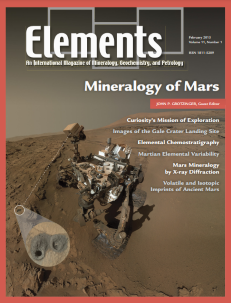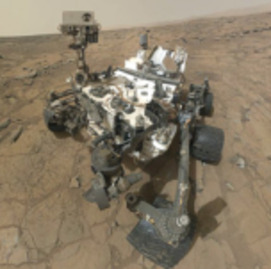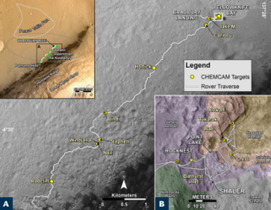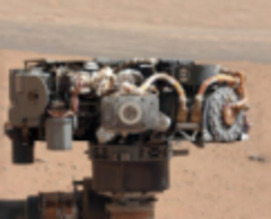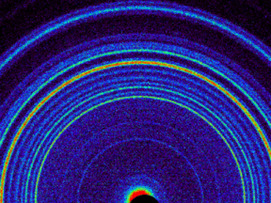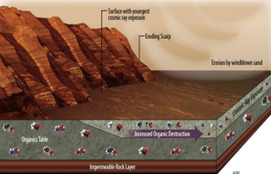
Mineralogy of Mars
John P. Grotzinger – Guest Editors
Table of Contents
The Mars Science Laboratory rover Curiosity touched down on the surface of Mars on August 5, 2012. Curiosity was built to search and explore for habitable environments. The rover has a lifetime of at least one Mars year (~23 months) and a drive capability of more than 20 km. The MSL science payload can assess ancient habitability, which requires the detection of former water, a source of energy to fuel microbial metabolism, and key elements such as carbon, sulfur, nitrogen, and phosphorus. Within 8 months of landing, we were able to confi rm full mission success. This was based on the discovery of fi ne-grained sedimentary rocks, inferred to represent an ancient lake. These rocks (Sheepbed mudstone) preserve evidence of an aqueous paleoenviron- ment that would have been suited to support a Martian biosphere founded on chemolithoautotrophy and characterized by neutral pH, low salinity, and variable redox states for both iron and sulfur species. C, H, N, O, S, and P were measured directly as key biogenic elements. The environment likely had a minimum duration of hundreds to tens of thousands of years. These results highlight the biological viability of fluvial–lacustrine environments in the ancient history of Mars and the value of robots in geologic exploration.
- Curiosity’s Mission of Exploration at Gale Crater, Mars
- Images from Curiosity: A New Look at Mars
- ChemCam: Chemostratigraphy by the First Mars Microprobe
- In Situ Compositional Measurements of Rocks and Soils with the Alpha Particle X-ray Spectrometer on NASA’s Mars Rovers
- Determining Mineralogy on Mars with the CheMin X-Ray Diffractometer
- Volatile and Isotopic Imprints of Ancient Mars
AHF Analysentechnik
Analytical Instrument Systems, Inc.
Australian Scientific Instruments (ASI)
Bruker Nano
Cambridge University Press
Cameca
Excalibur Mineral Corporation
Geochemist’s Workbench
JEOL
ProtoXRD
Rocks & Minerals
Savillex
Wiley
Zeiss
v11n2 Arc Magmatic Tempos
Guest editor: Scott R. Paterson (University of Southern California) and Mihai N. Ducea (University of Arizona)
Research over the past decade has established that magmatism in oce- anic and continental arcs is not temporally or spatially steady-state. The causes of well-documented order of magnitude increases in magmatic production over relatively short-lived, high-volume events remain con- troversial. Since the differentiation of our planet and formation of the continental crust and its underlying mantle lithosphere is in large part the result of magmatic processes at convergent margins, it is imperative that we understand the underlying controls on the tempo of magmatic and tectonic activity in arcs and the episodic nature of magmatism. These processes also influence socially important processes such as long-term climate change, volcanic and fault hazards, and ore deposi- tion. This issue will provide an overview of some recently developed models for episodic behavior in subduction magmatism, from global to single magmatic systems, and explore the causes of high-volume events in subduction-related magmas.
- Arc Magmatic Tempos: Gathering the Evidence Scott R. Paterson (University of Southern California) and Mihai N. Ducea (University of Arizona)
- High-Volume Magmatic Events in Subduction Systems Mihai N. Ducea, Scott R. Paterson, and Peter G. DeCelles (University of Arizona)
- Magma Production Rates for Intraoceanic Arcs Brian R. Jicha (University of Wisconsin) and Oliver Jagoutz (Massachusetts Institute of Technology)
- Quickening the Pulse: Fractal Tempos in Continental Arc Magmatism Shanaka L. de Silva (Oregon State University), Nancy R. Riggs (Northern Arizona University), and Andrew P. Barth (Indiana University–Purdue University Indianapolis)
- Collisional Processes and Links to Episodic Changes in Subduction Zones Jeroen van Hunen (Durham University) and Meghan S. Miller (University of Southern California)
- Global Continental Arc Flare-ups and Their Relation to Long-Term Greenhouse Conditions Cin-Ty A. Lee (Rice University) and Jade Star Lackey (Pomona College)
- Mineralogy of Mars (February 2015)
- Arc Magmatic Tempos (April 2015)
- Apatite (June 2015)
- Societal and Economic Impacts of Geochemistry (August 2015)
- Supergene Metal Deposits (October 2015)
- Geomicrobiology and Microbial Geochemistry (December 2015)
Download 2015 Thematic Preview


